Edible Landscape
Permaculture is an ecological approach to landscaping. It emphasizes perennial and annual food production in addition to aesthetics, habitat, microclimate control and other desirable functions that thoughtful arrangement of diverse plant communities can provide.
The AJLC’s edible landscape includes fruit trees, strawberries, blueberries, raspberries, and raised-bed organic vegetable gardens. The AJLC demonstrates the great potential for creating very local food in an urban environment.
Circular Garden
In the circular garden, every part of the bed can be easily reached from one of seven radiating walkways while the area for growing is maximized. Recycled bricks and salvaged building stones provide structure for the walkways and beds. Heat-trapping plastic covers can be placed over the beds to extend the growing season through the colder months. Northeast Ohio soils are heavy in clay content and the use of raised beds, combined with organic rich compost helps to maintain adequate drainage and high soil fertility in a small space.
Terraced Orchard
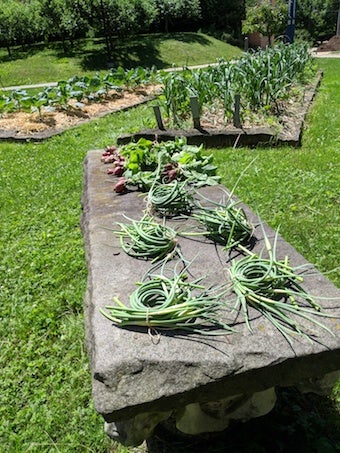
The terraced orchard berm located immediately north of the building reduces erosion and insulates the north wall of the building. The orchard consists of about 50 apple and pear trees. Varieties include McAfee and Liberty apples, and Bosque, Sekel, "Large Korean" and Yali Asian pears. The landscape already produces approximately 50 bushels of organically grown apples and pears per year, and several gallons of blueberries, serviceberries and raspberries.
The garden and orchard serve to demonstrate that even in urban and suburban settings, a significant fraction of our food needs can be produced in backyards and public spaces rather than relying solely on a contemporary food distribution system that transports food an average of 1,500 miles and burns 10 units of fossil fuel energy for each unit of food energy delivered to the table.
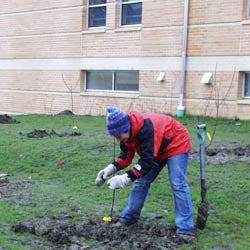
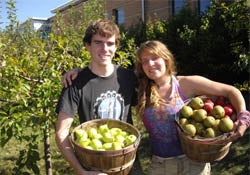
Experimental Hazelnut Orchard
An experiential neohybrid hazelnut orchard was planted in the summer of 2011, in a 1/10th-acre location to the west of the AJLC building between the parking lot solar array and the AJLC Annex. Hazelnuts and other “woody agriculture” crops represent an alternative to contemporary industrial agriculture that hold the promise of producing significant amounts of food while maintaining biodiversity and storing and capturing carbon in soils and biomass.
One hundred thirty-one, one-year-old seedlings were provided by agroforest/nut crop pioneer Philip Rutter ’75. The Oberlin study site at the AJLC functions as a satellite to research facilities at the Bagersett Research Corporation, located in Canton, Minnesota. The term “neohybrid” refers to a plant breeding technique Badgersett has developed that mixes three different hazel species into one gene pool. It is distinct from genetic engineering in that it replicates and accelerates natural evolutionary processes and maintains biodiversity; each tree in the Oberlin planting is a genetically distinct hybrid developed through this sophisticated breeding program.
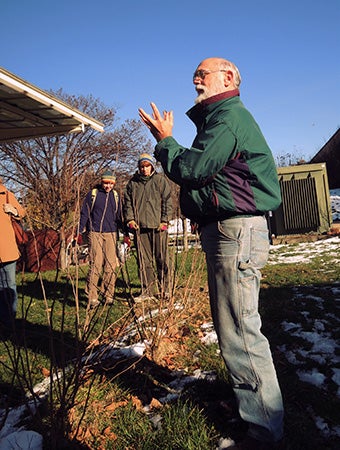
The hazel plants are bushes, not trees. As a result, they mature rapidly; the first small crop of nuts was harvested from the Oberlin planting in 2014, just three years after planting. By 2015, yield in the Oberlin plot was already approximately 1,000 lbs/acre (the expected yield of mature hybrid hazelnuts is between 1,000 and 4,000 lbs/acre). Hazels consist of a frilly, leaf-like husk, a nutshell, and a nut kernel contained inside the nutshell. The nut kernels are the primary food produced, although additional food crops can be coproduced, between the rows. Hazel kernels average 10-14 percent protein, and 50-60 percent edible oil, which is nearly chemically identical to olive oil.
In addition to direct consumption of nut kernels or incorporation of nut kernels into desert foods, they can be ground and used as flour in ways similar to flours produced from grains. The mass of nutshell in proportion tends to be 45-60 percent in the current genetics. The nutshells, typically a waste product, can be used as an annual fuel crop, harvested at the same time as the nut kernels. Nutshell can be burned directly, or can be gasified; according to British-Turkish research, gasified hazel shell is about 15 percent free hydrogen.
An additional fuel component of the hazel crop is the wood from the bushes, which is harvested by whole-bush/whole row coppice, typically performed every 8-12 years. Oberlin’s orchard growth has been greater than expected and coppicing will begin after year seven. Both wood and shell can have higher value uses than fuel, but markets must be developed.
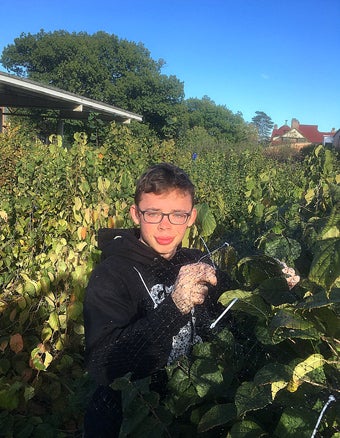
While Rutter’s work focuses on hybridization, the focus of Oberlin’s experimental hazel orchard is on response to fertilization. Starting in the summer of 2012, one group of trees has received an annual dose of fertilizer similar in composition and amount to the fertilizer applied to conventional corn/soybean crops in Northeast Ohio. A second group has received double this amount of fertilizer. The third received no fertilizer. The experimental system is designed to allow for assessment of impact of fertilization on woody biomass, annual leaf production, reproductive tissue production, and harvestable nut production.
While some differences in leaf production have been observed in some years, no clear effect of fertilization on nut production has yet been observed. This is good news; the substantial amounts of fertilizer necessary to support contemporary industrial agriculture are produced and applied using fossil fuels and result in significant ecological and economic damage to downstream bodies of water that receive agricultural runoff.